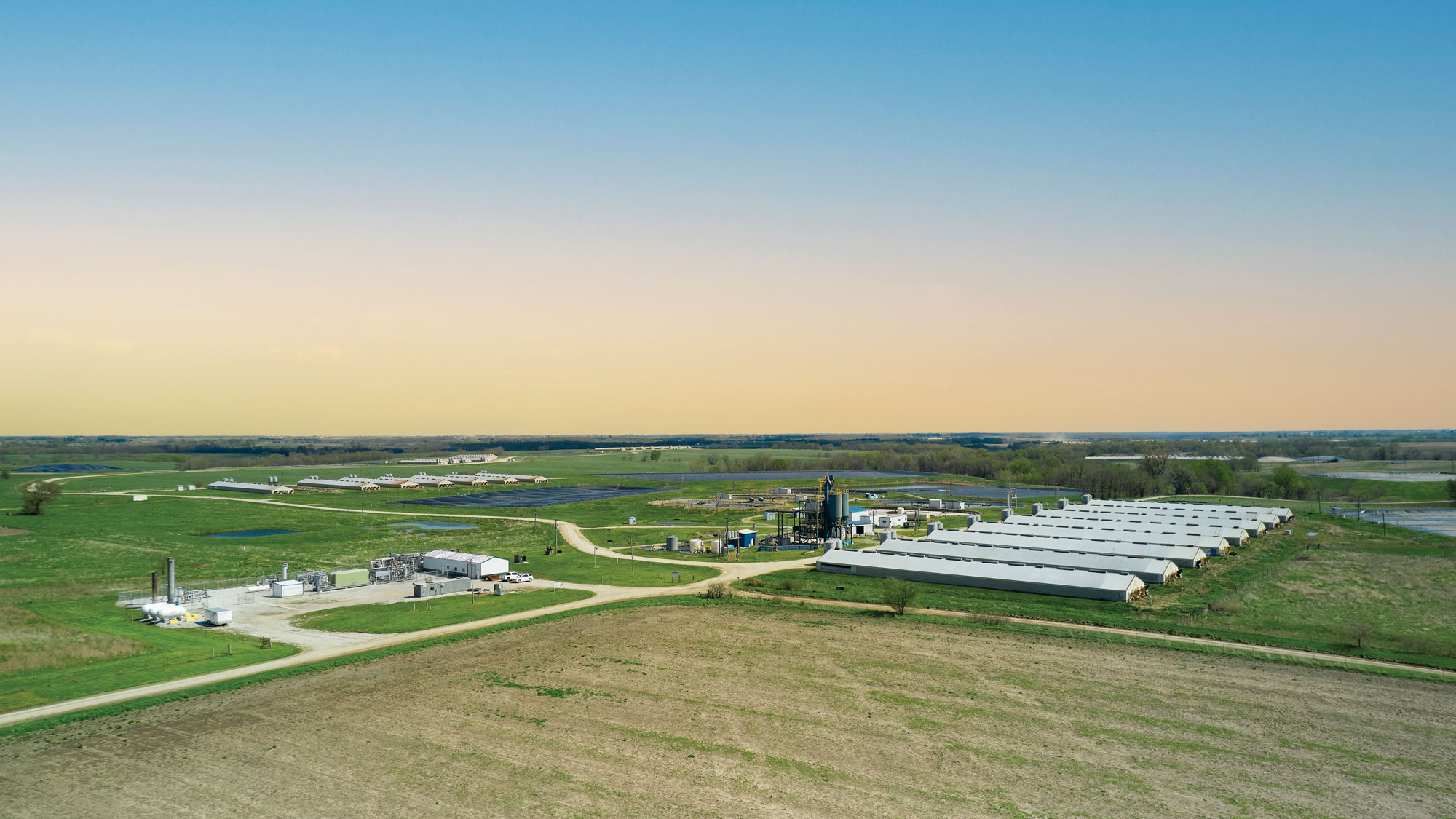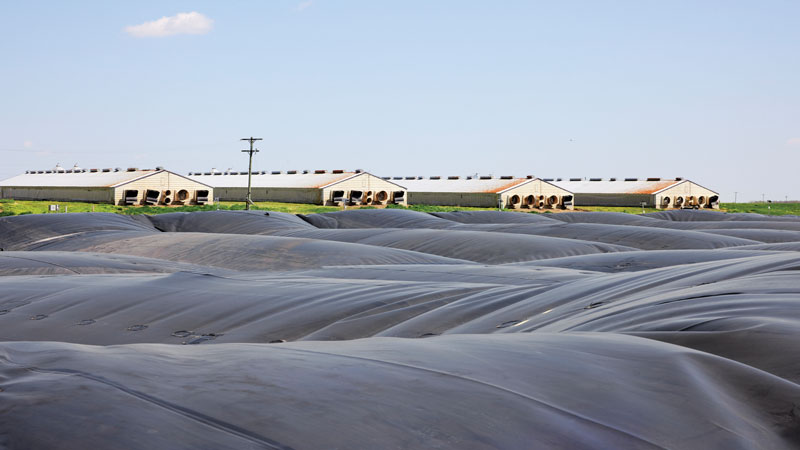
Making the Leap
June 7, 2021
Written By Neal Fandek
Smithfield Foods and Roeslein Alternative Energy Partnership Turns Waste into Energy
Concentrated animal feeding operations, or CAFOs, have been in the news lately for a variety of reasons. Can these operations be sustainable, create good jobs and benefit the environment, too? Critics would say, “When pigs fly.”
A joint venture called Monarch Bioenergy would beg to differ. On eight Smithfield Foods farms in northern Missouri, thousands of hogs may not be flying just yet, but their digestive byproducts are.
Hogs produce manure. Lots of manure. The manure and other wastes in most large-scale operations are funneled into huge outdoor lagoons. But where some people look at these lagoons and see problems, others see opportunity.
People like Rudi Roeslein (pronounced Race-line), an Austrian immigrant and St. Louis University engineering graduate who put his degree to good use designing and building beverage-can manufacturing systems. Roeslein & Associates has grown to become a global engineering firm with offices in the United States, Brazil, Europe and China and annual revenues in the hundreds of millions.
“If you drink out of an aluminum can, we probably built the factory that made it,” Roeslein quips.
Roeslein is more than a successful industrialist. He’s also an avid outdoorsman dedicated to improving wildlife habitat, soil and water quality on his nearly 2,000-acre farm near Unionville, Mo. Roeslein puts his money where his mouth is, too. He was named the Conservation Federation of Missouri Air Conservationist of the Year, among other awards and honors.
His company engineered impermeable, high-density polyethylene coverings for those lagoons to trap the raw gas and convert it to consumer-quality renewable natural gas (RNG). The partnership between Smithfield Foods and Roeslein Alternative Energy, called Monarch Bioenergy, purifies the gas then feeds it into existing pipelines to be sold locally.
“I could have taken my $57 million and bought a ranch next to Ted Turner somewhere and lived happily ever after,” Roeslein has been quoted as saying. “But I’ve seen what’s happened around the world. I couldn’t have slept thinking I was sitting on the sidelines doing nothing when there was this great opportunity to show the world there was a different way to do things.”
Monarch Bioenergy is believed to be the largest project of its kind in the United States. When complete, the project is expected to produce more than 2.2 billion cubic feet of pipeline-quality gas per year, or the equivalent amount of energy produced by 17 million gallons of diesel fuel.
Brandon Butler, director of communications for Roeslein Alternative Energy, says all eight farms and 83 lagoons were operational by June 1. And that $57 million Roeslein refers to is his personal investment in this technology.
The project also dovetails with a 2016 Smithfield goal to reduce its environmental impact. “25 by 25,” led by Smithfield Renewables for Smithfield Foods, sought to reduce greenhouse gas emissions 25 percent by 2025. They’ve since upped the ante by committing to become carbon negative in all company-owned U.S. operations by 2030. Smithfield has additional manure-to-RNG projects on farms in North Carolina, Virginia and Utah.
Converting methane to RNG removes at least 25 times more greenhouse gasses from the atmosphere than are released during its use in power plants, homes, vehicles or businesses, says Kraig Westerbeek, senior director of Smithfield Renewables. That means using RNG effectively removes carbon from the atmosphere.
And the northern Missouri RNG is unusually pure, with one of the industry’s lowest carbon intensity scores, -392. Ethanol has a score of around +40. Carbon intensity is basically the emission rate of a pollutant relative to the intensity of a specific activity or industrial production process. The score is like a golf score: the lower the better. All this is just the beginning. Roeslein thinks big. He wants to restore 30 million acres of prairie and other natural habitats.
“We know it’s feasible,” says Butler. He cites that there are about 22 million acres in the Conservation Reserve Program (CRP) today, and that landowners want to put more acreage in. CRP statistics back this up: In mid-2020, 1.9 million acres were accepted into the program, more than three times the number accepted during the last signup period in 2016.
Roeslein Alternative Energy’s plan, says Butler, is to out-compete the government by working with landowners and row crop farmers to set aside more acres that can then be planted with prairie grasses and other native species, which can then be harvested for biomass and turned into, you guessed it, RNG. The firm purchases two types of fuel from MFA Oil: propane, which acts as an accelerant to burn off undesirable gasses like hydrogen sulfide in the RNG project; and diesel for the prairie initiative to run skid loaders, tractors and other heavy equipment. The RNG project also uses recycled water to flush the barns.
But is the prairie restoration initiative realistic?
Dr. Lisa Schulte Moore, professor of natural resource ecology at Iowa State University, thinks so. She is a co-recipient of a federal grant with Roeslein Alternative Energy, among others, to develop new methods of turning biomass and manure into fuel.
“One challenge with CRP is it’s not well-aligned with farmers’ intrinsic motivation to produce for markets,” she says. “What Rudi is developing does align with that intrinsic motivation. My experience is that farmers want to keep their soil and protect the environment, but obviously their first concern is staying in business. So, if Rudi and his team can create a value chain where planting prairie clearly helps their bottom lines, I think they will get on board.”
Schulte Moore compares Roeslein’s vision with the Apollo program: “If you’re going to get to the moon, you have to have that big idea to rally folks around. Then you have to do the determined and detailed work of figuring out how to get there.”
Butler says converting marginal land back to prairie will ultimately benefit wildlife, farmers and the planet. “It’s (prairie) nature’s sponge, and almost all of it is gone now, turned into row crops.” Most row crops have shallow roots, which contributes to erosion, topsoil depletion and flooding. More prairie means less degradation.
Westerbeek, of Smithfield Renewables, says the Monarch project is a “holistic vision that utilizes land resources, prevents fertilizer runoff into watersheds, improves soil organic matter, and cools the atmosphere through natural transpiration while creating critical new wildlife and pollinator habitat.” Pollinators like monarch butterflies, hence the project’s name.
“This isn’t greenwashing,” Butler adds, referring to the term used to describe companies claiming environmental friendliness to burnish their image and boost sales. “We are improving the environmental footprint, creating jobs, generating millions of dollars.” Roeslein Alternative Energy has 55 employees and hires many contractors. Add in the Smithfield jobs, and this stretch of northern Missouri becomes a good place to live, work and raise a family again.
All these efforts may sound like small steps. But together they could mean a giant leap for mankind.





